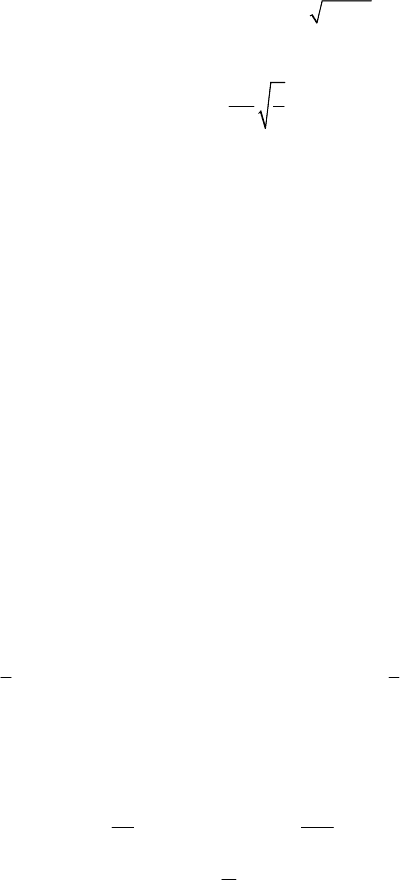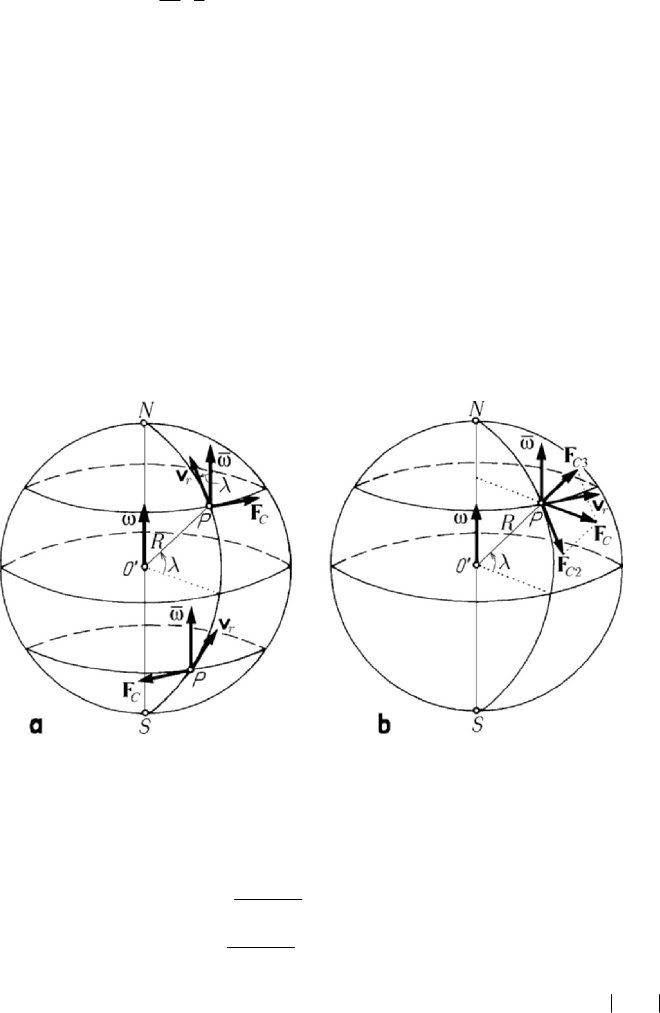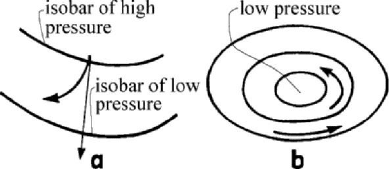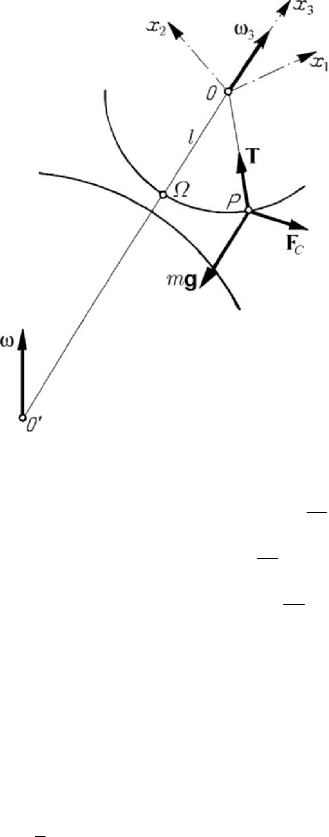Teodorescu P.P. Mechanical Systems, Classical Models Volume I: Particle Mechanics
Подождите немного. Документ загружается.


Other considerations on particle dynamics
643
224
22
2
1
1 cos sin 2 ...
8
gR R
gg
g
ωω
λλ
′′
=− + +
′′
′
, (10.2.49)
obtaining thus the terrestrial acceleration
g (the practical acceleration), as a function of
the gravity acceleration
g
′
(the theoretical acceleration), at any latitude on the Earth
surface; replacing
R by Rh
+
, we get g as function of the altitude h from the sea
level too. The terms which contain
()
2
2
/Rgω
′
can be, in general, neglected. Thus, we
obtain, with a good approximation, the relation which links the terrestrial acceleration
to the gravity one
2
2
1cos
R
gg
g
ω
λ
⎛⎞
′
′
=−
⎜⎟
′
⎝⎠
. (10.2.50)
At the poles (
/2λπ
′
=±
) we have gg
′
=
; in reality, this equality is approximate,
because the Earth is not a sphere, but a spheroid and the distribution of masses is only
approximately with spherical symmetry. At the equator (
0λ
′
=
), at the sea level, we
get
2
1
e
R
gg
g
ω
⎛⎞
′
=−
⎜⎟
′
⎝⎠
; (10.2.50')
we notice that this result is an exact one, corresponding also to the formula (10.2.48').
Besides, the maximal difference
gg
′
−
is obtained at the equator. Numerically, we
have
23 2
/ 3.4636 10 1/288.717 1/289 (1/17)Rgω
−
′
≅⋅≅ ≅=
, where we have
considered the Earth as a sphere of radius
8
6.371 10 cmR =⋅ and we have assumed
that
2
978.1 cm/sgg
′
≅≅ . Hence, if the Earth would be rotating about its axis with
an angular velocity of
3
17 1.240 10 rad/sω
−
≅⋅ , the particles situated at the equator
would be weightless.
In reality, the formulae obtained above have a certain degree of approximation, due
to the model of sphere assumed for the Earth. If one takes into account that the Earth is
a spheroid (e.g., in the classical theory of Clairaut), then one obtains the possibility to
determine the gravity acceleration
g
′
corresponding to a parallel on the Earth surface;
the theoretical acceleration
g may be thus calculated. As a matter of fact, even using
the formulae (10.2.48)-(10.2.50) one cannot obtain
g without knowing g
′
; but one can
state that the difference
0gg
′
−> is sufficiently small.
Using a model closer to the physical reality, one can establish the formula
980.60509 2.5028 cos 2 0.0003ghλ=− −, (10.2.51)
which gives the terrestrial acceleration in
2
cm/s , as a function of the geographical
latitude
λ (the practical latitude) and of the height h in cm , over the sea level. We

MECHANICAL SYSTEMS, CLASSICAL MODELS
644
find thus, at the sea level (
0h
=
),
2
978.1 cm/s
e
g = at the equator (result used
before) and
2
983.1 cm/s
p
g = at the poles. At the latitude 45λ =° (which
corresponds with a good approximation for Bucharest too) one obtains
2
45
980.6 cm/sg
°
= which represents the mean of the extreme values of the terrestrial
acceleration. We notice that
(
)
45
/ 0.0050989
pe
ggg
°
−
= , so that the theoretical
acceleration has a variation of maximum
0.5% .
Projecting the relation (10.2.45) on the practical vertical
QP (Fig.10.12), we get
2
cos cos cos( )
gg
i
mg mg mRαωλλα
′′′
=− +
;
if we put
g
i
mm= , neglect the angle α with respect to λ
′
, and take
cos 1α ≅
, then
we find again the formula (10.2.50) for
0h
=
.
Observing that
cosgg α
′′
⋅=gg
, the formula (10.2.48) leads to
22 242
2cos cosgg gg Rαω λ
′
′′
+− =
;
taking into account (10.2.48'), we find
2
2
cos 1 cos
gR
gg
ω
αλ
′
⎛⎞
′
=−
⎜⎟
′
⎝⎠
, (10.2.52)
relation which puts into evidence the degree of approximation of the formula (10.2.50)
(approximation
cos 1α ≅
). We may then also calculate (we take further into
consideration the relation (10.2.48'))
22
sin sin 2 sin 2
22
RgR
ggg
ωω
αλ λ
′
′
′
==
′
; (10.2.52')
as a matter of fact, this relation could be obtained as projection of the relation (10.2.45)
on a normal to the theoretical vertical
PO
′
(Fig.10.12). The relations (10.2.52),
(10.2.52') are exact, in comparison with the relations (10.2.46') and correspond to the
relation (10.2.46) (for
1k = ). As well, the calculation of the angle
max
α for 45λ
′
=°
is justified too.
The formula (10.2.52) is an exact one in the frame of the spherical model used for
the Earth. Eliminating
2
Rω between (10.2.52) and (10.2.52'), we find the relation
sin
sin( )
gg
λ
λα
′
′
=
′
+
, (10.2.53)
which is exact too. As a matter of fact, this result may be obtained by projecting the
relation (10.2.45) on a normal to the centrifugal force
c
F (Fig.10.12).

Other considerations on particle dynamics
645
2.2.8 Deviation towards the east in the free falling of a heavy particle
Let us return to the equations of motion of a heavy particle at the Earth surface
(10.2.33'), where we take
=
F0, and let us put ()
E
Pgg
′
=
≅f , corresponding to
the results of the preceding subsection. The first approximation (10.2.35) with the
initial conditions (10.2.36) leads to
(0)
00
11
1
xvtx=+,
(0)
00
22
2
xvtx=+,
(0)
20 0
33
3
1
2
xgtvtx=− + +
. (10.2.54)
Assuming that the particle is falling from a height
h with the velocity
0
v from a point
of the local vertical (in what follows, by local vertical we mean only the theoretical
vertical, directed towards the centre of the Earth, considered to be spheric), we take
00
12
0xx==,
0
3
xh= ; in case of a free falling (
0
=
v0), the motion takes place as
the Earth would be fixed (in a first approximation the motion of rotation of the Earth is
neglected).
In a second approximation, the equations (10.2.35') with the initial conditions
(10.2.36') allow to write
()
(1)
3002
23
1
1
cos sin cos
3
xgt v v tλλλ=+−,
(1)
02
1
2
sinxvtλ=− ,
(1)
02
1
3
cosxvtλ= .
Remaining at this approximation (hence, neglecting
2
ω as well as higher powers of
ω ), we get the solution
()
300200
12311
1
( ) cos sin cos
3
xt gt v v t vt xωλ λ λω=+− ++
,
02 0 0
21 22
() sinxt v t vt xωλ=− + + , (10.2.54')
(
)
0200
31 33
1
() cos
2
xt v gt vt xωλ=−++
,
which contains also the influence of the motion of rotation of the Earth (in a first
approximation).
In case of a free falling of a heavy particle along the local vertical (
0
=v0) from the
height
h , we get
3
1
1
cos
3
xgtωλ=
,
2
0x
=
,
2
3
1
2
xgth
=
−+; (10.2.55)
the results in Subsec. 2.2.1 are thus completed with a component in the positive
direction of the
1
Ox -axis. Hence, the heavy particle in free falling does not describe the
descendent vertical, but an arc of semicubic parabola
2
232
13
8
()cos
9
xhx
g
ω
λ=−
, (10.2.55')

MECHANICAL SYSTEMS, CLASSICAL MODELS
646
and reaches the Earth after an interval of time
2/thg= with a deviation towards the
east (corresponding to
1
0x > , Fig.10.8) equal to
3/2
1max
22
cos
3
xh
g
ω
δλ==
. (10.2.55'')
Considering the mean value
2
980.6 cm/sg =
and taking into account (10.2.24), we
obtain
6 3/2
2.195 10 coshδλ
−
=⋅ , (10.2.55''')
where
h is taken in cm , the deviation being obtained in the same units. The
experimental verifications have put in evidence a good concordance with the theoretical
results. Thus, in 1831, Reich has made experiments in the mines of Freiburg (to avoid
the influence of the wind and of the other influences at the Earth surface), at a latitude
51λ =° and a falling height
4
1.585 10 cmh
=
⋅ ; the average value
exp
2.83 cmδ =
of 106 experiments has been in good correspondence with the theoretical result
2.76 cmδ = . We notice that for a height
4
10 cmh
=
one has 2.195 cosδλ
=
, and
the deviation is obtained in cm; e.g., at Bucharest (
45λ
=
° ) one has 1.55 cmδ = . At
the poles (
/2λπ=± ) we get 0δ
=
. The maximal deviation takes place at the equator
(
0λ = ,
2
978.1 cm/sg =
) and is given by
63/2
2.198 10 hδ
−
=
⋅ (δ and h in cm );
hence,
max
2.20 cmδ ≅ in free falling from
4
10 cm 100 mh
=
= .
If we launch a heavy particle along the ascendent local vertical (
0
=r0,
00
12
0vv==,
0
3
0v > ), we get
302
13
1
cos cos
3
xgt vtωλωλ=−,
2
0x
=
,
20
33
1
2
xgtvt=− + ; (10.2.56)
the component
0
33
vgtv=− + of the velocity along the vertical vanishes at the moment
0
3
/tvg
′
= , for which we get
()
2
0
33
1
()
2
xt v
g
′
=
,
()
3
0
13
2
2
() cos 0
3
xt v
g
ω
λ
′
=
−<,
()
2
0
13
() cos 0vt v
g
ω
λ
′
=
−<.
The rotation of the Earth about its axis leads thus to a deviation towards the west of the
particle. Taking the position and the velocity at the moment
t
′
as initial conditions and
studying further the motion of the particle, we find that it takes place also in a plane
normal to the local meridian; the particle returns on the Earth at the moment
0
3
22/ttvg
′′ ′
==
at the point of co-ordinates
1
()xt
′
′
=
(
)
2
(4/3) /gω−
()
3
0
3
cosv λ
1
2()xt
′
= 0
<
,
3
() 0xt
′′
= , tangent at the vertical of this location (
1
() 0vt
′′
= ,

Other considerations on particle dynamics
647
0
33
()vt v
′′
=− ); it results further a deviation towards the west, equal to that obtained in
case of the ascendent motion (unlike the case of the free falling, the influence of the
velocity
1
() 0vt
′
< takes place).
In case of an approximation of higher order, when terms in
2
ω intervene too, it is
necessary to take into account the variation of
g with the height, as well as the force of
attraction of the Moon.
2.2.9 Coriolis’ force. Baer’s law
The deviation along a tangent to the local parallel, considered in the preceding
subsection, is due to the action of Coriolis’ force
2
r
C
m
=
−×Fv
ω
. The equations of
motion of the heavy particle (10.2.33') read (with respect to the local frame of
reference, Fig.10.8)
12 3
2( sin cos)xx xωλ λ=− ,
21
2sinxxωλ
=
− ,
31
2cosxgxωλ
=
−+ ,
(10.2.57)
in the absence of the centrifugal force; integrating, with the initial conditions
0
(0) =rr
,
0
(0) =vv
, we can write
(
)
(
)
[
]
000
122 33 1
2sin cosxxx xx vωλ λ=− −− + ,
(
)
00
211 2
2sinxxxvωλ
=
−− + , (10.2.57')
(
)
00
3113
2cosxgt xx vωλ
=
−+ − + .
This system of linear differential equations can be easily integrated; as a matter of fact,
eliminating
2
x and
3
x between the first equation (10.2.57) and the last two equations
(10.2.57'), we get
(
)
220 0 0
11 1 2 3
442cos2sincosxx xgt v vωωωλωλ λ+=+ + − . (10.2.57'')
By integration, it results
()
(
)
00 0
132 1
1cos
( ) cos sin (1 cos 2 ) sin 2
22
g
xt v v t v t
λ
λλ ω ω
ωω
⎡⎤
=− − − − −
⎢⎥
⎣⎦
0
1
cos
2
g
tx
λ
ω
++
.
(10.2.58)
Replacing in the last two equations (10.2.57') and integrating, we obtain also the
solutions
()
(
)
00 0
232 1
sin cos
( ) cos sin sin 2 (1 cos 2 )
22
g
xt v v t v t
λλ
λλω ω
ωω
⎡⎤
=− − + − −
⎢⎥
⎣⎦
()
200 0
23 2
sin 2
cos cos sin
4
g
tvvtx
λ
λλ λ−+ ++
.
(10.2.58')

MECHANICAL SYSTEMS, CLASSICAL MODELS
648
()
(
)
00 0
332 1
cos cos
() cos sin sin2 (1 cos2 )
22
g
xt v v t v t
λλ
λλω ω
ωω
⎡⎤
=−+−−
⎢⎥
⎣⎦
()
2
200 0
23 3
sin
sin cos sin
2
g
tvvtx
λ
λλ λ−+ ++
.
(10.2.58'')
With the aid of the series expansions
33
sin 2 2 (2 ) /6 ...tt tωω ω
=
−+,
22
cos2 1 (2 ) /2 ...ttωω=− + and neglecting the terms in
2
ω or of higher degree, we
find again the solution (10.2.54'), obtained in the preceding subsection; as a matter of
fact, in the following considerations we will use this solution, which puts in evidence
(from a qualitative point of view), in a simpler way, various mechanical phenomena.
If we assume that the heavy particle is launched in a meridian plane (
1
0x = ), then
we take
0
=r0 and
0
1
0v = ; we obtain
()
3002
123
1
( ) cos sin cos
3
xt gt v v tωλω λ λ=+−
, (10.2.59)
so that the particle is deviated from the initial plane. As well, if the particle is launched
in a plane normal to the local meridian (
0
=
r0 and
0
2
0v
=
), it results
02
21
() sinxt v tωλ=− , (10.2.59')
hence a tendency of deviation from this plane.
Let us consider the motion in a plane tangent to the Earth sphere (
3
0x = ) at the
considered location (we take
0
=
r0 and
0
3
0v
=
); we can write (with respect to the
local frame of reference, Fig.10.8)
3020
121
1
() cos sin
3
xt gt v t vtωλωλ=++
,
02 0
21 2
() sinxt v t vtωλ=− + , (10.2.60)
(
)
02
31
1
() cos
2
xt v gtωλ=−
.
We notice that
0
1
2cosgvωλ
(taking into account (10.2.24), we have
0
1
2cosgvωλ> , even if the component
0
1
v of the initial velocity is equal to the second
cosmic velocity); it results
3
() 0xt
<
. Hence, the particle remains on the Earth surface
and we may assume that the motion (in the vicinity of the initial position with respect to
the Earth sphere) takes place in the tangent plane
3
0x
=
. A constraint force N
(normal to the tangent plane, hence along the local vertical), which impedes the particle
to leave the plane
3
0x = is also acting in this case. The theorem of kinetic energy
(10.2.16') allows to write

Other considerations on particle dynamics
649
(
)
2
d1
0
d2
rrr
mv m
t
=
⋅+⋅=gv Nv ,
so that
0
const
r
vv
=
= (result which can be accepted with a good approximation).
We can thus express the components of the velocity in the form
0
1
() cosvt v α= ,
0
2
() sinvt v α= , where ()tαα
=
is the angle made by the velocity
r
v with the
1
Ox -
axis. Replacing in one of the first two equations (10.2.57) (where we make
3
0x = ),
we find, after identification,
2sinαωλ
=
− ; hence,
0
() 2 sinttααωλ
=
− . (10.2.61)
Thus, we get
Theorem 10.2.12 (Baer’s law). In the boreal hemisphere, the angle α decreases,
corresponding to a deviation towards the right of the heavy particle, while in the
austral hemisphere the angle
α increases, corresponding to a deviation towards the
left of it.
Figure 10.13. Action of the Coriolis force upon a particle on the Earth surface: launching along
the tangent to the meridian (a); launching in the boreal hemisphere
along the tangent to the parallel towards the east (b).
Taking into account (10.2.61), one can show, by integration, that
0
0
1
() sin( 2 sin )
2sin
v
xt tαωλ
ωλ
=− − ,
0
0
2
() cos( 2 sin )
2sin
v
xt tαωλ
ωλ
=−,
so that the trajectory of the particle is circular; the radius of the circle is
0
/2 sinv ωλ
and is very great (we take into account (10.2.24)) and we can approximate it by its
tangent at the initial moment.

MECHANICAL SYSTEMS, CLASSICAL MODELS
650
We notice that, with respect to the gravity force, we have
5
2 / 2 / 1.487 10
rr r
mmgvg vω
−
×≤≅⋅vω , where
r
v
is expressed in m/s ; it
results that Coriolis’ force may be, in general, neglected in case of a particle subjected
to relative small velocities.
Let us consider, in particular, the case in which the particle
P is launched in the
boreal hemisphere, along the tangent to the meridian, e.g., towards the north
(Fig.10.13,a); in this case, Coriolis’ force will be directed towards the east, tangent to
the parallel which passes through
P , having the magnitude 2sin
r
C
Fmvωλ
=
. From
(10.2.59) we obtain a deviation towards the east given by
302
12
1
() cos sin 0
3
xt gt vt
ωλω λ
=
+>.
If the particle
P
would be moving along the meridian towards the south point, then the
Coriolis’ force would be directed towards the west. In both cases corresponds a
deviation towards the right, in conformity to Baer’s law. In the austral hemisphere, the
phenomenon is symmetric to that of the boreal hemisphere, with respect to the
equatorial plane; thus, if the relative velocity is directed towards the north point, then
Coriolis’ force will be directed towards the west. Coriolis’ force vanishes at the equator
and is maximal at the poles (
max
2
r
C
Fmvω
=
); starting from one of the poles, the
deviation will always take place towards the west. Thus, after a time
t
, the distance
vt
will be travelled through, corresponding a linear deviation
2
r
vtω and an angular
deviation equal to
2
/
rr
vt vt tωω= , hence equal to the angle by which the Earth is
rotating in that interval of time. Hence, a projectile launched from a pole has a
rectilinear trajectory; its apparent deviation is due to the fact that the Earth is rotating.
Thus, after 1 min 30 s one obtains an angular deviation of
0.0065628
rad, hence of
approximative
22 34
′′′
, which cannot be neglected.
The effect of Baer’s law is considerable in case of great continuous mechanical
systems. For instance, the right bank of the rivers which run from the south towards the
north or from the north towards the south, in the boreal hemisphere, is caving more then
the left bank; we mention thus the rivers at the north of Asia (which run from the south
to the north), which have the tendency of displacement towards the east. Due to the
Coriolis force too, at the railway lines which are directed approximately along a
meridian, being travelled through in a unique direction, the rail at the right is subjected
to a greater wear (the east rail if the direction of circulation is from the south to the
north or the west one in case of a circulation in the opposite direction). As well, the
trade winds are directed towards the equator; the colder air (hence, heavier) tends to
replace the warmer one (hence, lighter) in the boreal hemisphere from the north towards
the south, while in the austral hemisphere from the south towards the north. Indeed, the
wind is a mass of air in motion; in the absence of the Coriolis force, the direction of the
motion corresponds to the gradient of the atmosphere pressure (from a high pressure to
a low one, normal to the isobar lines). The intervention of the Coriolis force leads to a
deviation towards the west (Fig.10.14,a) for the boreal hemisphere. In the state of
equilibrium, the configuration of the wind is stationary; Coriolis’ force is in equilibrium
with the forces due to the pressure, so that the wind becomes parallel to the isobar lines.

Other considerations on particle dynamics
651
A zone of low pressure surrounded by isobar lines forms a cyclone. Due to Coriolis’
force, the wind is circulating around the cyclone, counterclockwise in the boreal
hemisphere (Fig.10.14,b) and clockwise in the austral one.
Figure 10.14. Formation of trade winds (a) and of cyclones (b) in the boreal hemisphere.
Let us study now the case in which the particle
P is launched, in the boreal
hemisphere, along the tangent to the parallel, e.g., towards the east (Fig.10.13,b); in this
case, the Coriolis’s force is contained in the meridian plane and is normal to the poles’
line, being directed towards the exterior of the Earth (the same direction as the
centrifugal force) and having the magnitude
2
r
C
Fmvω
=
. We decompose the force
C
F in two components: the force
3C
F along the ascendent local vertical, which has the
tendency to make smaller the weight of the particle, and the force
2C
F , tangent to the
meridian and directed towards the south, which has the tendency to deviate the particle
in that direction (in conformity to the formula (10.2.59')); if the particle
P is launched
in the austral hemisphere, towards the east too, then to the component
2C
F of Coriolis’
force corresponds a deviation towards the north (hence, in both cases, towards the
equator). In the case in which the particle is launched towards the west, in any of the
two hemispheres, Coriolis’ force and its components have an opposite direction; thus,
the component
3C
F has the tendency to augment the weight of the particle, while the
component
2C
F leads to a deviation towards the poles (towards the north in the boreal
hemisphere and towards the south in the austral one).
The effects of the Coriolis’ force can be put into evidence at the atomic level too.
Thus, the polyatomic molecules have an aggregate motion of rotation, while the atoms
oscillate around their positions of equilibrium; hence, the atoms are in relative motion
with respect to a frame rigidly linked to the molecule. The Coriolis’ forces are non-
zero, leading to a displacement of the atoms in a direction normal to that of the original
oscillations.
2.2.10 Foucault’s pendulum
Let us consider the motion of a heavy particle on a fixed sphere at the Earth surface
in the boreal hemisphere; the spherical pendulum thus obtained is called the Foucault
pendulum, after Léon Foucault, who made a famous experiment with such a pendulum
in 1815, at the Pantheon, in Paris. We assume that the particle
P (in fact a spheric
ball), of mass
m , is hanged up at the end of a flexible and inextensible thread, of length
l , fixed at the pole O of the local (non-inertial) frame of reference. The equation of
motion is written in the form

MECHANICAL SYSTEMS, CLASSICAL MODELS
652
2
rr
mmm
=
−×+a
g
vT
ω
, (10.2.62)
where
T is the tension in the thread (the constraint force arises because the particle is
constrained to stay on the sphere of centre
O and radius l ) and where the influence of
the centrifugal force has been neglected with the respect to Coriolis’s force (
2
ω has
been neglected with respect to
ω ). In components, we obtain (Fig.10.15)
Figure 10.15. The Foucault pendulum.
()
1
123
2sincos
x
mx m x x T
l
ωλ λ=−−
,
2
21
2sin
x
mx m x T
l
ωλ=− − , (10.2.62')
3
31
2cos
x
mx mg m x T
l
ωλ=− + − ;
the relation of holonomic and scleronomic constraint
2222
123
0xxxl
+
+−= (10.2.62'')
is added to these equations. The elementary work of the constraint force is, in this case,
equal to zero, so that the theorem of kinetic energy (10.2.15') leads to
(
)
2
3
1
ddd
2
r
mv m mg x=⋅=−gr , (10.2.63)
wherefrom we get the first integral of energy
